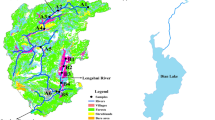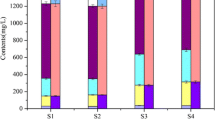Abstract
The use of phosphorus (P) inactivating agents to reduce internal P loading from sediment for lake restoration has attracted increasing attention. Reasonably, the physicochemical properties of P inactivating agents may vary with the interference of various environmental factors, leading to the change of control effectiveness and risks. In this study, the effect of fulvic acid (FA) adsorption on the properties of two agents, drinking water treatment residuals (DWTRs) and Phoslock®, was investigated. The results showed that after adsorption, there was little change for the main structures of DWTRs and Phoslock®, but the thermostability of Phoslock®, as well as the particle size and settleability of the two agents decreased. The specific surface area and pore volume of DWTRs also decreased, while those of Phoslock® increased. Further analysis indicated that aluminum and iron in DWTRs were stable during FA adsorption, but a substantial increase of lanthanum release from Phoslock® was observed, in particular at first (P < 0.01). Moreover, the P immobilization capability of DWTRs had little change after FA adsorption, while the capability of Phoslock® after FA adsorption decreased in solutions (P < 0.001) and sediments (P < 0.1); interestingly, from the view of engineering application, the performance of Phoslock® was not substantially affected. Overall, each P inactivating agent had its own particular responses of the physicochemical properties to environment factors, and detailed investigations on the applicability of each agent were essential before practical application.







Similar content being viewed by others
References
Agyin-Birikorang S, Oladeji OO, O’Connor GA, Obreza TA, Capece JC (2009) Efficacy of drinking-water treatment residual in controlling off-site phosphorus losses: a field study in Florida. J Environ Qual 38:1076–1085
Babatunde AO, Zhao YQ (2007) Constructive approaches towards water treatment works sludge management: an international review of beneficial re-uses. Crit Rev Environ Sci Technol 37:129–164
Barry MJ, Meehan BJ (2000) The acute and chronic toxicity of lanthanum to Daphnia carinata. Chemosphere 41:1669–1674
Bian S, Mudunkotuwa IA, Rupasinghe T, Grassian VH (2011) Aggregation and dissolution of 4 nm ZnO nanoparticles in aqueous environments: influence of pH, ionic strength, size, and adsorption of humic acid. Langmuir 27:6059–6068
Chen M, Ye T-R, Krumholz LR, Jiang H-L (2014) Temperature and cyanobacterial bloom biomass influence phosphorous cycling in rutrophic lake sediments. PLoS ONE 9:e93130
Erhayem M, Sohn M (2014) Stability studies for titanium dioxide nanoparticles upon adsorption of Suwannee River humic and fulvic acids and natural organic matter. Sci Total Environ 468–469:249–257
French RA, Jacobson AR, Kim B, Isley SL, Penn RL, Baveye PC (2009) Influence of ionic strength, pH, and cation valence on aggregation kinetics of titanium dioxide nanoparticles. Environ Sci Technol 43:1354–1359
Gołdyn R, Podsiadłowski S, Dondajewska R, Kozak A (2014) The sustainable restoration of lakes—towards the challenges of the water framework directive. Ecohydrol Hydrobiol 14:68–74
Gomes AFS, Lopez DL, Ladeira ACQ (2012) Characterization and assessment of chemical modifications of metal-bearing sludges arising from unsuitable disposal. J Hazard Mater 199–200:418–425
Habibiandehkordi R, Quinton JN, Surridge BWJ (2015) Long-term effects of drinking-water treatment residuals on dissolved phosphorus export from vegetated buffer strips. Environ Sci Pollut Res 22:6068–6076
Huser BJ, Pilgrim KM (2014) A simple model for predicting aluminum bound phosphorus formation and internal loading reduction in lakes after aluminum addition to lake sediment. Water Res 53:378–385
Ippolito JA, Barbarick KA, Elliott HA (2011) Drinking water treatment residuals: a review of recent uses. J Environ Qual 40:1–12
James WF (2011) Variations in the aluminum: phosphorus binding ratio and alum dosage considerations for Half Moon Lake, Wisconsin. Lake Reservoir Manage 27:128–137
Kandori K, Ishikawa T (2001) TPD–MS–TG study of hematite particles produced by the forced hydrolysis reaction. Phys Chem Chem Phys 3:2949–2954
Kleeberg A, Herzog C, Hupfer M (2013) Redox sensitivity of iron in phosphorus binding does not impede lake restoration. Water Res 47:1491–1502
Kothawala DN, Stedmon CA, Müller RA, Weyhenmeyer GA, Köhler SJ, Tranvik LJ (2014) Controls of dissolved organic matter quality: evidence from a large-scale boreal lake survey. Glob Chang Biol 20:1101–1114
Lin L, Xu X, Papelis C, Cath TY, Xu P (2014) Sorption of metals and metalloids from reverse osmosis concentrate on drinking water treatment solids. Sep Purif Technol 134:37–45
Lürling M, Tolman Y (2010) Effects of lanthanum and lanthanum-modified clay on growth, survival and reproduction of Daphnia magna. Water Res 44:309–319
Lürling M, Waajen G, van Oosterhout F (2014) Humic substances interfere with phosphate removal by lanthanum modified clay in controlling eutrophication. Water Res 54:78–88
Macias F, Caraballo MA, Nieto JM (2012) Environmental assessment and management of metal-rich wastes generated in acid mine drainage passive remediation systems. J Hazard Mater 229–230:107–114
Mackay EB, Maberly SC, Pan G, Reitzel K, Bruere A, Corker N, Douglas G, Egemose S, Hamilton D, Hatton-Ellis T, Huser B, Li W, Meis S, Moss B, Lürling M, Phillips G, Yasseri S, Spears BM (2014) Geoengineering in lakes: welcome attraction or fatal distraction? Inland Waters 4:349–356
Makris KC, Harris WG, O’Connor GA, Obreza TA, Elliott HA (2005) Physicochemical properties related to long-term phosphorus retention by drinking-water treatment residuals. Environ Sci Technol 39:4280–4289
Márquez-Pacheco H, Hansen AM, Falcón-Rojas A (2013) Phosphorous control in a eutrophied reservoir. Environ Sci Pollut Res 20:8446–8456
Meis S, Spears BM, Maberly SC, Perkins RG (2013) Assessing the mode of action of phoslock (R) in the control of phosphorus release from the bed sediments in a shallow lake (Loch Flemington, UK). Water Res 47:4460–4473
Özkundakci D, Hamilton DP, Gibbs MM (2011) Hypolimnetic phosphorus and nitrogen dynamics in a small, eutrophic lake with a seasonally anoxic hypolimnion. Hydrobiologia 661:5–20
Parfitt RL, Fraser AR, Farmer VC (1977) Adsorption on hydrous oxides. III. Fulvic acid and humic acid on goethite, gibbsite and imogolite. Eur J Soil Sci 28:289–296
Poschenrieder C, Gunsé B, Corrales I, Barceló J (2008) A glance into aluminum toxicity and resistance in plants. Sci Total Environ 400:356–368
Reedyk S, Prepas EE, Chambers PA (2001) Effects of single Ca(OH)2 doses on phosphorus concentration and macrophyte biomass of two boreal eutrophic lakes over 2 years. Freshw Biol 46:1075–1087
Reitzel K, Hansen J, Jensen HS, Andersen FØ, Hansen KS (2003) Testing aluminum addition as a tool for lake restoration in shallow, eutrophic Lake Sønderby, Denmark. Hydrobiologia 506:781–787
Reitzel K, Andersen FØ, Egemose S, Jensen HS (2013a) Phosphate adsorption by lanthanum modified bentonite clay in fresh and brackish water. Water Res 47:2787–2796
Reitzel K, Lotter S, Dubke M, Egemose S, Jensen HS, Andersen FØ (2013b) Effects of Phoslock® treatment and chironomids on the exchange of nutrients between sediment and water. Hydrobiologia 703:189–202
Salman M, El-Eswed B, Khalili F (2007) Adsorption of humic acid on bentonite. Appl Clay Sci 38:51–56
Spears BM, Lürling M, Yasseri S, Castro-Castellom AT, Gibbs M, Meis S, McDonald C, Mclntosh J, Sleep D, van Oosterhout F (2013a) Lake responses following lanthanum-modified bentonite clay (Phoslock®) application: an analysis of water column lanthanum data from 16 case study lakes. Water Res 47:5930–5942
Spears BM, Meis S, Anderson A, Kellou M (2013b) Comparison of phosphorus (P) removal properties of materials proposed for the control of sediment p release in UK lakes. Sci Total Environ 442:103–110
Spears BM, Maberly SC, Pan G, Mackay E, Bruere A, Corker N, Douglas G, Egemose S, Hamilton D, Hatton-Ellis T, Huser B, Li W, Meis S, Moss B, Lürling M, Phillips G, Yasseri S, Reitzel K (2014) Geo-engineering in lakes: a crisis of confidence? Environ Sci Technol 48:9977–9979
Sunding MF, Hadidi K, Diplas S, Løvvik OM, Norby TE, Gunnæs AE (2011) XPS characterisation of in situ treated lanthanum oxide and hydroxide using tailored charge referencing and peak fitting procedures. J Electron Spectrosc 184:399–409
Tang W-W, Zeng G-M, Gong J-L, Liang J, Xu P, Zhang C, Huang B-B (2014) Impact of humic/fulvic acid on the removal of heavy metals from aqueous solutions using nanomaterials: a review. Sci Total Environ 468–469:1014–1027
Tinnacher RM, Nico PS, Davis JA, Honeyman BD (2013) Effects of fulvic acid on uranium (VI) sorption kinetics. Environ Sci Technol 47:6214–6222
USEPA (2007) SW-846 method 3051: microwave assisted acid digestion of sediments, sludges, soils and oils. U S Environmental Protection Agency, Washington DC
USEPA (2008) Fate, transport and transformation test guidelines: OPPTS 835. 1230—adsorption/desorption (batch equilibrium). U S Environmental Protection Agency, Washington DC
van Oosterhout F, Lürling M (2011) Effects of the novel 'Flock & Lock' lake restoration technique on Daphnia in Lake Rauwbraken (the Netherlands). J Plankton Res 33:255–263
van Oosterhout F, Lürling M (2013) The effect of phosphorus binding clay (Phoslock®) in mitigating cyanobacterial nuisance: a laboratory study on the effects on water quality variables and plankton. Hydrobiologia 710:265–277
Wang S, Yi W, Yang S, ** X, Wang G, Wu F (2011) Effects of light fraction organic matter removal on phosphate adsorption by lake sediments. Appl Geochem 26:286–292
Wang CH, Qi Y, Pei YS (2012a) Laboratory investigation of phosphorus immobilization in lake sediments using water treatment residuals. Chem Eng J 209:379–385
Wang CH, Wang ZY, Lin L, Tian BH, Pei YS (2012b) Effect of low molecular weight organic acids on phosphorus adsorption by ferric-alum water treatment residuals. J Hazard Mater 203–204:145–150
Wang CH, Gao SJ, Pei YS, Zhao YQ (2013a) Use of drinking water treatment residuals to control the internal phosphorus loading from lake sediments: laboratory scale investigation. Chem Eng J 225:93–99
Wang CH, Liang JC, Pei YS, Wendling LA (2013b) A method for determining the treatment dosage of drinking water treatment residuals for effective phosphorus immobilization in sediments. Ecol Eng 60:421–427
Wang CH, Yuan NN, Pei YS (2014) An anaerobic incubation study of metal lability in drinking water treatment residue with implications for practical reuse. J Hazard Mater 274:342–348
Yamashita T, Hayes P (2008) Analysis of XPS spectra of Fe2+ and Fe3+ ions in oxide materials. Appl Surf Sci 254:2441–2449
Yan M, Dryer D, Korshin GV, Benedetti MF (2013) In situ study of binding of copper by fulvic acid: comparison of differential absorbance data and model predictions. Water Res 47:588–596
Yang Y, Zhao YQ, Kearney P (2008) Influence of ageing on the structure and phosphate adsorption capacity of dewatered alum sludge. Chem Eng J 145:276–284
Yang M, Lin J, Zhan Y, Zhu Z, Zhang H (2015) Immobilization of phosphorus from water and sediment using zirconium-modified zeolites. Environ Sci Pollut Res 22:3606–3619
Yuan CG, Shi JB, He B, Liu JF, Liang LN, Jiang GB (2004) Speciation of heavy metals in marine sediments from the East China Sea by ICP-MS with sequential extraction. Environ Int 30:769–783
Zamparas M, Zacharias I (2014) Restoration of eutrophic freshwater bymanaging internal nutrient loads. A review. Sci Total Environ 496:551–562
Zhao YQ, Zhao XH, Babatunde AO (2009) Use of dewatered alum sludge as main substrate in treatment reed bed receiving agricultural wastewater: long-term trial. Bioresour Technol 100:644–648
Acknowledgments
This work was supported by grants from the project of Nan**g Institute of Geography and Limnology (NIGLAS2014QD02), the Special Foundation on Water Pollution Control and Treatment of China (2012ZX07101-010), and the 135 project of Nan**g Institute of Geography and Limnology, CAS (No. NIGLAS2012135008).
Author information
Authors and Affiliations
Corresponding author
Additional information
Responsible editor: Philippe Garrigues
Electronic supplementary material
Below is the link to the electronic supplementary material.
ESM 1
(DOCX 1062 kb)
Rights and permissions
About this article
Cite this article
Wang, C., Jiang, HL., Xu, H. et al. Variation of physicochemical properties of drinking water treatment residuals and Phoslock® induced by fulvic acid adsorption: Implication for lake restoration. Environ Sci Pollut Res 23, 351–365 (2016). https://doi.org/10.1007/s11356-015-5209-9
Received:
Accepted:
Published:
Issue Date:
DOI: https://doi.org/10.1007/s11356-015-5209-9




